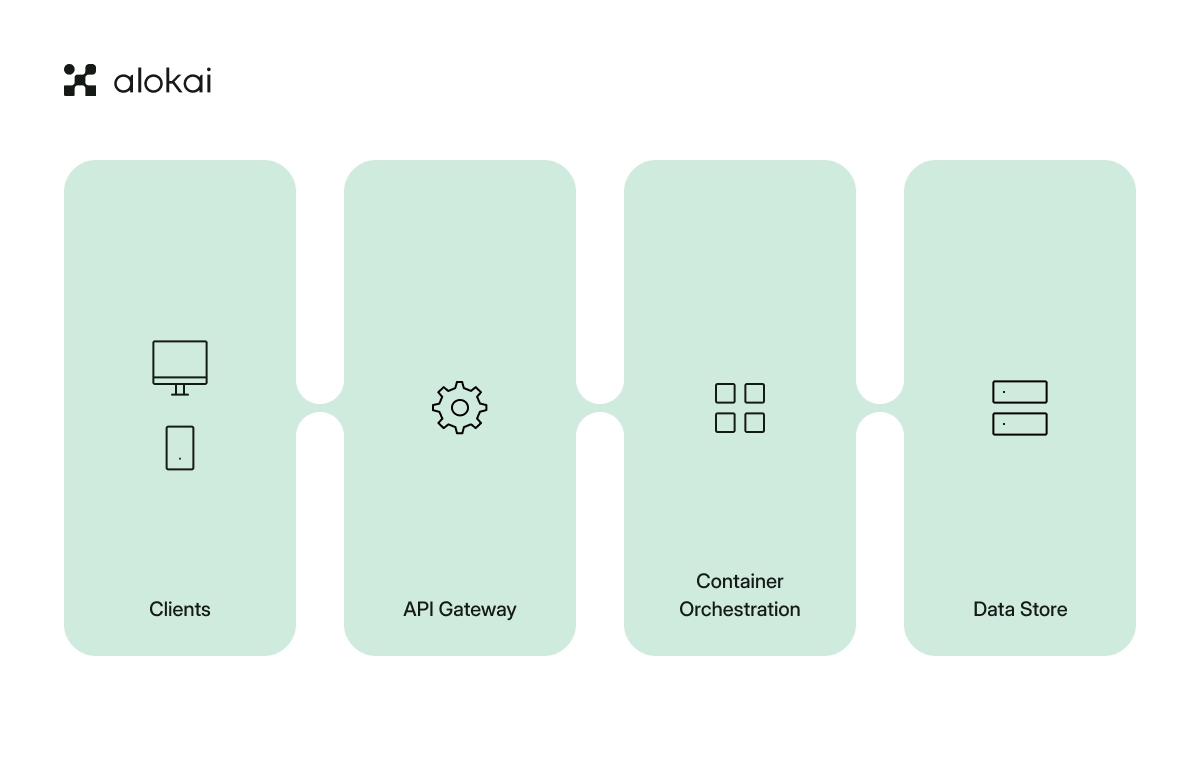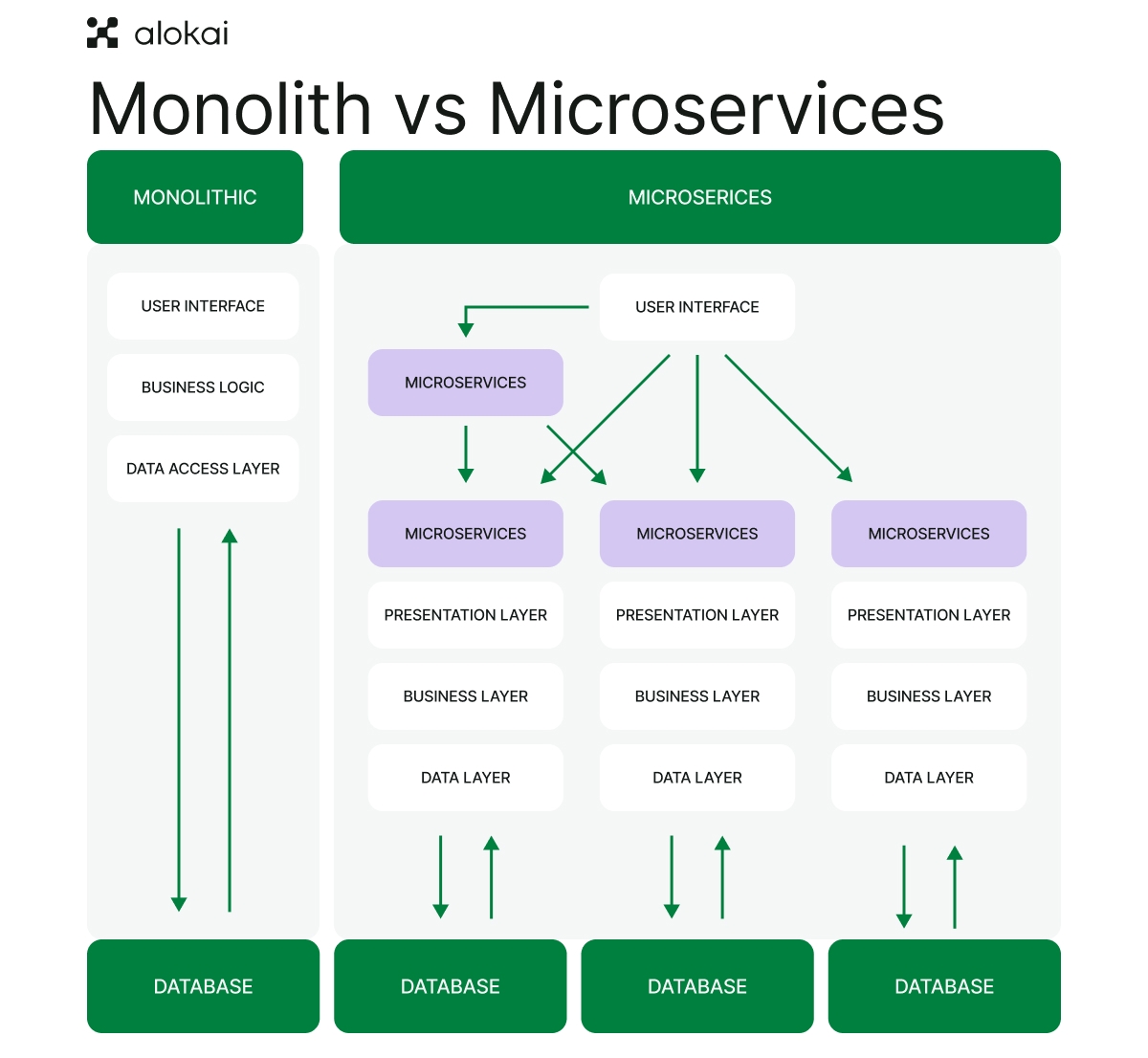Building a new ecommerce platform from scratch or changing your tech stack can be tedious and time-consuming, which is why it's crucial to choose the right architecture approach for your business needs.
Here, there are two paths you can follow:
Monolithic
Microservices
Monolithic and microservices architectures are two popular approaches for building online stores. Both have specific benefits, and choosing which to use depends on the project's particular needs.
So how do you make that choice? This article will explore the pros and cons of monolithic vs. microservices-oriented architecture and help you decide which is best for your ecommerce business.
We'll also discuss when to make the switch from one to the other and how to do it without impacting your daily operations and budget (yes, it is possible!)
First, let's start with the basic concepts: the definition of microservices and monolithic architecture.
What is microservices architecture?

The basic idea behind microservices architecture is to split up applications into small, self-contained services that can be deployed and updated separately from the rest of the system. This allows for more speed, flexibility, and scalability as they can be deployed on different servers and scaled independently.
Microservice-style applications communicate directly via APIs without going through centralized points. So instead of your app having many different types and sizes of services, each component will only need lightweight libraries provided by their respective vendor frameworks.
Because of this, microservices architecture can be better for development teams that want to build fast, scalable systems with high availability rates. Using microservices is a modern and practical approach to meet evolving user needs and experiences that are becoming increasingly important, especially in enterprise projects.
In enterprise projects, meeting fast-changing user needs and providing valuable experiences is becoming increasingly important to ensure growth. Using microservices architecture makes it possible to address those needs quickly and keep up with shifts in the market.
Learn about microservices orchestration and how to ensure that each service works seamlessly within an app ecosystem
A lot depends on the complexity and size of your business; this will be one of the most significant factors in deciding whether to go with microservices vs. monolithic legacy systems. If you plan to expand your ecommerce business, then you might need to consider migrating from a monolithic to a microservices architecture.
The core of microservices architecture: the API-first approach
This API-first approach is the secret sauce to many of the benefits offered by microservices in terms of performance and scalability:
An API-first approach makes it easier to integrate third-party applications with your eCommerce system – you can easily plug in and unplug your chosen solutions.
It makes it easier to scale your eCommerce system, as you can add new functionality by simply adding new APIs.
This approach makes it easier to test your eCommerce system, as you can test each integration independently.
Microservice architecture is an excellent solution for maintaining data integrity because each microservice has its own database. If one service experiences a problem, other services won't be affected. This also enables each application to use the database best suited to its needs.
Learn about the difference between microservices and API
Key microservices principles
1. Microservices are built around business capabilities: Microservices won't be restricted from adopting appropriate tech stacks or a backend database storage most suitable for solving specific business problems. They can adapt on a per-case basis.
2. Microservices have a single responsibility: It's part of the SOLID design pattern which simplifies any microservice by delivering only one core functionality. For example, if you need 5 functionalities, you need 5 microservices with separate databases.
3. Microservices are designed with failure in mind: When one microservice goes down, it won't affect the entire system. This is the most important reason why microservices architecture is increasingly popular in ecommerce businesses; all other functionalities remain intact when one module fails.
What is monolithic architecture?
Monolith architecture is a more traditional approach to ecommerce setup where the entire application is built as a single unit. This can make the development and deployment more straightforward, but it also makes the application slower and more challenging to scale.
A monolithic application is more complex to update and maintain than one using microservices, which is one of the biggest disadvantages of monolithic architecture. Additionally, it is an almost impossible task to scale individual parts of such an application because all components are bundled together.

Monolith vs. microservices: Pros and cons of both architectures
Monolithic and microservices architectures both have their fair share of pros and cons.
To make an informed business decision about the right tech stack, it's vital to understand your options clearly. In the next section, we go through the biggest advantages and disadvantages of monolith and microservices architecture.
Monolithic architecture: Advantages
All-in-one system with lots of features. The features provide all the components needed for handling business logic, displaying UI layers, managing and publishing content, and more with a single, tightly coupled codebase.
Simplified development and deployment. By consolidating all components into a single, unified codebase, monolithic architecture makes it easy to manage and test. Deployment involves a single unit (like a JAR or WAR file), reducing the overhead of managing multiple deployment pipelines.
A consistent development approach and style. This way you can improve collaboration and code quality among team members.
Monolithic architecture: disadvantages
It's vital for ecommerce businesses to fully understand these drawbacks when making decisions about the choice of architecture as for some businesses, a monolithic application can pose real challenges.
Hard to update and maintainance. Monoliths are known for often blocking marketing teams from upgrading a specific product, campaign, or component.
Higher costs. A centralized architecture does not allow for broader collaboration between independent development teams. You need larger in-house teams or subcontractors, which affects revenue and ROI.
Challenges on the UX level. You are limited to working with only one technology, which more often than not makes it challenging to integrate with other applications or APIs, negatively affecting user experience and performance.
Debugging issues. A bug can potentially crash your entire environment and it can take weeks to identify and isolate the hot spot as you need to scan hundreds of lines of code. This directly affects your conversion rates.
Vertical scaling makes monoliths difficult and expensive to scale as additional computational resources are added, which results in lengthy and costly development cycles.
Poor protection against downtime. Because the whole system is tightly linked, an issue anywhere in the code can take down an entire monolithic application, which is detrimental to your daily operations and sales.
It's true that for many years monolithic architecture represented a seemingly convenient “all-in-one” approach and guaranteed complete control of the system for ecommerce businesses.
However, it's also important to note that over time, and with rapidly changing user behavior, the drawbacks became a blocker to ecommerce businesses needing to scale and diversify to meet market trends and demands.
In addition, these types of systems make it challenging if you need additional features added post-launch since all changes must go through the codebase itself - braces included.
When evaluating microservices vs. monolithic on a case-by-case basis, the latter can still be a workable option for meeting the needs of a smaller organization. But only if you're not planning for expansion into new markets and product lines.
In other cases, microservices unlock more exciting opportunities.
Microservices architecture: Advantages
Microservices offer both business and technical advantages over traditional monolithic architectures. Here, we'll go through both in detail.
Business advantages of microservices
They are easier and more cost-effective to develop and maintain since you need a smaller dev team.
Microservices focus on one function at a time, which leads to higher performance and speed.
Faster performance leads to increased conversion rates.
Microservices are much more scalable due to individual deployment, allowing your business to grow as rapidly as needed without any technology blockers.
Based on your business requirements, you can use different best-of-breed technology for each microservice.
It is easy to add new features since you can implement different business requirements as additional services and loosely couple them. This independence from each other also means updates are way easier.
Technical advantages of microservices
Less start-up and deployment time is needed.
Microservices are easy to manage due to their smaller code size.
It is easier to scale specific services as needed instead of scaling the entire monolithic application.
Increased agility and flexibility as microservices architecture allows developers to work on smaller, self-contained units of code. They can iterate on features without completely redeploying the application.
Developers only need to understand a singular microservice providing the functionality they will be working on instead of the entire system. This can speed up development.
It reduces the complexity of the application as it consists of smaller, independent components. It also minimizes the risk of bugs and errors.
Microservices architecture: disadvantages
Despite the many advantages of microservices, some notable drawbacks can impact their effectiveness for certain businesses.
It's important to consider these limitations to fully assess if microservices are the right fit for your organization, whether you're building a new ecommerce or considering migration from one architecture to the other.
The important cons of a microservices architecture are:
Adopting microservices involves an initial learning curve for developers to become familiar with new tools and practices. This initial adjustment period can temporarily slow down development.
Debugging can be slightly more complex in a microservices environment due to the distributed nature of the system. However, with proper logging and monitoring tools, this complexity is manageable and does not significantly hinder development.
Configuring and managing the deployment of multiple services requires a more sophisticated setup compared to the deployment of monolithic applications.
Monolithic vs. microservices architecture: Operational differences that impact ecommerce
Monolithic and microservices architectures each come with a set of operational advantages and challenges. Understanding these operational differences is crucial for ecommerce businesses aiming to optimize their systems.
Here, we'll take a look at the main operational differences between microservices and monolithic architecture in:
Development
Testing
Deployment
Scalability
Fault tolerance
Development
Monolithic architecture: The large code base makes it harder for developers and QAs to understand the code and business knowledge. As such, you'll end up needing a bigger IT team as the code base grows.
Microservices architecture: The pluggability of a microservices application architecture allows for easier and faster development. This approach makes it possible for cross-functional teams to develop services independently, which leads to faster turnaround times.
Testing
Monolithic architecture: With a monolith, you often have to test the entire application as a whole, which is more complex.
Microservices architecture: You can test each service independently, which makes the process easier.
Deployment
Monolithic architecture: Monolithic applications are packaged and deployed as a single unit, so the development process is quite simple. That said, deploying the entire application increases the risk that a single failure can affect the entire system.
Microservices architecture: With microservices, you can deploy individual services independently, making it easy to roll out new updates. However, since it involves handling multiple services, each with its own deployment pipeline, dependencies, and potential for integration issues, the process can become quite complex.
Scalability
Monolithic architecture: Monoliths are often extremely difficult to scale, leaving you with no option but to replatform or rebuild when the business grows and expands.
Microservices architecture: With microservices, you can simply add more service instances, new markets (perfect for multistore developments), and new products when you need to increase capacity.
Fault tolerance
Monolithic architecture: If one part of the application fails with a monolith, the entire system may go down.
Microservices architecture: Microservices are more fault-tolerant than monoliths because a single service can continue working even if another service fails.
When to consider migrating from monolith to microservices?
The choice between building a monolithic applicationor one that leverages a microservices architecture is essential for the future of your ecommerce business. Both approaches offer unique solutions to critical technical and business needs such as:
Flexibility to change and update features
Scalability
High ROI
Short time-to-market
Agility
Both can deliver robust and diverse apps, but their code base and functionality loos vastly different, and each serves unique business needs.
The microservices approach is ideal for businesses needing scalability and agility. That's because each microservice can be developed, deployed, and scaled independently, allowing teams to address specific needs without affecting the entire system. This supports rapid growth and adaptation to changing market demands.
Monolithic architecture is easier to manage initially and may work well for smaller projects with straightforward requirements. However, as the application grows, maintaining and scaling a tightly coupled codebase becomes challenging.
A lot depends on the complexity and size of your business; this will be one of the most significant factors in deciding whether to go with microservices vs. monolithic legacy systems. If you plan to expand your ecommerce business, then you might need to considermigrating from a monolithic to a microservices architecture.

















